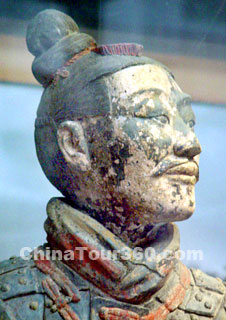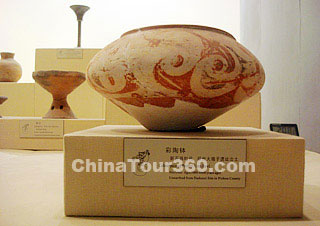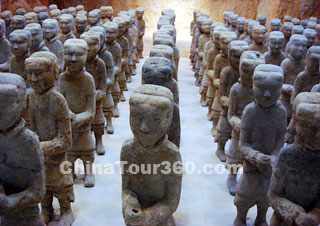 |
| The Qin Dynasty Terracotta Warrior |
At the early stage of the Neolithic Age, pot had to be made by hands. Clay was coiled into ropes and then carefully smoothed using a paddle on the exterior pressed against an anvil on the inside wall. Later till the primitive Yangshao Culture period, potter wheel was invented, and kiln was bettered, the production of pottery made a leap. The representative pottery then was red earthenware decorated with black animal, especially fish, frogs, deers and birds, geometric such as triangles and broad lines, plues woven patterns like lines, basket and string woven. During the Longshan Culture period, end of the Neolithic Age, fast wheel was used and pottery reached a record height, represented by the white pottery and eggshell-thin black pottery. The white pottery were mainly used as household utensils by the noble slave owners, so they were covered with all kinds of pattern such as animals' faces, clouds and wave designs. The black pottery, as the name suggests, is made into black, which is actually sooted at the last section when it is produced. The black pottery is known for its shapes but not the patterns on the surface.
During the Zhou Dynasty (11th century - 771 BC), pottery wares gained variety of designs and decorations. Faience, which was mainly buried with the dead, appeared in the Shang Dynasty. Until the Qin Dynasty (221 BC - 207 BC), pottery industry stepped into a new era. The world famous Qin Terra-cotta Warriors and Horses excavated in Xian, Shaanxi, astonished archaeologists for the marvelous techniques. Innovations and experimentations went on in later dynasties until in the Tang Dynasty (618 - 907) thus another great leap forward was made. The tri-colored pottery appeared! The sharp colored pottery won world reputation. Since in the Tang Dynasty, people emphasized luxurious funeral, nice and delicate pottery wares were always served as grave goods which included statues of officials, dancers, warriors and animals.
In the Song Dynasty, pottery was gradually replaced by porcelain. To the Ming Dynasty (1368 - 1644), purple clay pottery blossomed, which, was and still is, specially produced in Yixing, Jiangsu, since there's no purple clay in other places. The purple clay teapots are the favorites of many people in China, especially the tea lovers.
Fahua pottery was also famous in the Ming Dynasty. The pottery, in the south of Shanxi province, was ovened at low temperature. Usually, human figures, pavilions, peonies, and birds were painted upon in peacock blue, green, purple and white.
|
|









